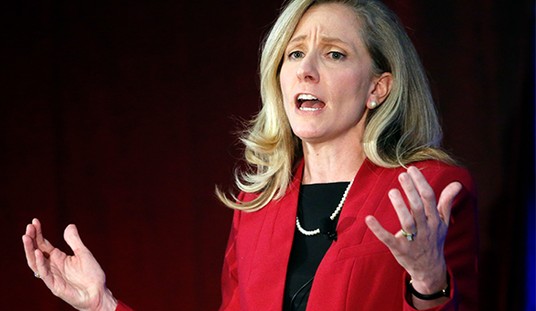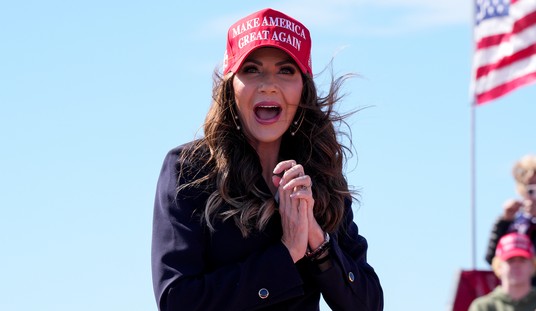One clear lesson has emerged from this midterm election — voters do not respond to lectures. That’s true whether it’s about climate change, the ridiculous “war on women” meme, Kochsteria, or anything else that activists think they can make a centerpiece of an election. Unfortunately for some, that became a very expensive lesson — even for those trying to make expensive lessons a lesson in themselves:
Embracing the irony of setting up a super PAC that would spend big money in order to fight super PACs and other groups that spend big money, Harvard professor Larry Lessig and GOP strategist Mark McKinnon went all-in on the idea voters would kick megadonors to the curb.
Tuesday, voters shrugged and cast their ballots for business as usual, leaving Mayday and Lessig — who emerged as its public personae — facing questions about the disconnect between its bold predictions and results.
Mayday PAC burst onto the political scene in the spring of 2014 with grandiose designs to elect a pro-campaign finance reform majority to the U.S. Congress by 2016. The 2014 cycle was a test run of sorts — with the group spending more than $10 million on a slate of candidates ostensibly united only in their belief in curbing the influence of big donors, lobbyists and money in the political system.
It was money down the drain.
Senate hopefuls Rick Weiland and Greg Orman and House candidates Paul Clements, Staci Appel and Rep. Carol Shea-Porter — all lost, despite Mayday’s much-touted, high-profile investments in those races. The setbacks across the country on Tuesday follow on the heels of a loss in the New Hampshire primary, when Mayday PAC backed a losing GOP challenger to Scott Brown. In the only race where Mayday PAC backed a winner — supporting Republican Rep. Walter Jones’ in North Carolina — it was hard-pressed to claim credit, since Jones’ reelection to a safe GOP seat was all-but assured without outside help.
And instead of getting one step closer to a pro-campaign finance reform majority, voters on Tuesday elected enough Senate Republican to handover control of the Senate to Republican Mitch McConnell — perhaps the leading opponent of Mayday’s vision. McConnell has long opposed campaign money restrictions as infringements on free speech and impediments to the free exchange of ideas.
Why did this fail? In large part, because only a relatively small number of people worry about the impact of big money in elections to the exclusion of everything else. The waste of money and resources left Lessig and McKinnon with enough egg on their faces that Lessig uncharacteristically has declined to engage with the media since the election results made the scope of his failure clear.
The same can be said about Tom Steyer, the Democratic megadonor who plowed $57 million of his own cash (some estimates range as high as $74 million) into the midterms in an attempt to make climate change a central campaign issue. Slate pointed out on Election Eve that Steyer, and not the oft-demonized Koch brothers, was the biggest outside spender in the race, and ended up with a marginalized issue and very little in results:
This election cycle’s biggest spender—at least among those who operate through the fully disclosed part of the political system, a.k.a. not the Koch brothers—is liberal billionaire Tom Steyer, who doled out at least $57 million of his own cash to try to get voters to care about climate change. The League of Conservation Voters (LCV), an environmental group, dumped another $25 million this year into the 2014 races, about $5 million more than it spent in 2010 and 2012 combined. All told, environmentalist organizations say they’ll pour $85 million into the midterms. As LCV president Gene Karpinski declared proudly to the Washington Post late last month, “This is by far the biggest investment that the environmental community has ever made in politics.”
What has all that green gotten these green groups? Not a whole heck of a lot.
Steyer and his like-minded allies opened their checkbooks with the hopes of making climate change a front-burner issue. But as the most expensivemidterm election in American history wraps up, it’s clear that environmentalists will fall far short of that goal. A Pew Research Center poll from September found that the environment came in a distant eighth among a list of 11 campaign issues that matter most to voters.
After Tuesday night, former Harry Reid aide Jim Manley succinctly summed up Steyer’s efforts:
Former hedge fund trader Tom Steyer became a billionaire by making brilliant investments. But his political investments mostly went belly-up Tuesday, a fate his critics were quick to attribute to noveau riche mistakes in his first big foray in the national money game. …
“He and his team are probably going to have to take a step back and rethink this,” said Jim Manley, a former aide to Senate Majority Leader Harry Reid. “The fact of the matter is this election wasn’t and never was going to be about climate change.”
Asked how Steyer had performed this cycle, one prominent Democratic donor said, “In a word: badly.”
Michael Bloomberg spent more than $20 million in this cycle, all but $500,000 on Democrats and liberal causes. How many gun-control advocates won election to the House or Senate on Tuesday night? In gubernatorial races? To state legislatures, which went more Republican than they have been in decades?
This lesson didn’t just get taught to outside groups and activists, either. Democrats tried making the midterms about contraception and abortion, and in Colorado’s Senate race, almost exclusively so. Women, as it turns out, had other issues in mind and didn’t care to be patronized, as I point out in an I told you so column in The Fiscal Times:
The results of the election also demonstrated the intellectual and political failure of Democratic strategy in the midterm elections, especially on the so-called “war on women.” My column last week predicted that Colorado’s Senate race would be the Waterloo for this particular demagoguery, and the results speak clearly for themselves. Incumbent Democrat Mark Udall got heckled by a major Democratic donor at a campaign stop two days before the election, for obsessing over contraception and abortion. “Who is running the worst campaign? Him,” Leo Beserra later explained, “because [expletive] abortion is all he talks about.”
How well did that work out for Udall? He lost his seat by 80,000 votes to Cory Gardner in an election where fellow Democratic Governor John Hickenlooper managed to eke out a re-election victory by 26,000 votes. Udall ended up winning among women who voted by nine points, but lost men by 16 points – and women only made up 48 percent of the Colorado electorate, their worst showing in 22 years. The “war on women” meme didn’t boost turnout, and in fact may have depressed turnout with its rank paternalism, especially in the infamous “Sweet Pea” ad sponsored by NARAL and funded by climate change activist Tom Steyer.
The war on women backfired on Democratic women running for office, too. In Texas, Wendy Davis’ entire oeuvre revolved around her filibuster against a highly popular late-term abortion ban. Few expected her to compete against Greg Abbott, but no one expected her to lose among women by nine points, 54/45, while losing two-thirds of male voters.
In Kentucky, where Democrats hoped to use the “war on women” strategy against Mitch McConnell to woo women and younger voters, Alison Lundergan Grimes ended up narrowly losing the female vote, 47/50 and in a virtual tie with McConnell among 18-29-year-olds at 48/47. Nationally, women only gave Democrats a five-point edge in midterm voting, far short of the double-digit gender gap they expected.
There isn’t really much mystery to this. Poll after poll showed that the issues that voters had most on their minds were the economy, government operation, jobs, and the deficit. Gallup’s analysis showed that climate change and contraception were among the “bottom five” issues in the midterms, and gun control and “big money in elections” didn’t even make it onto the list. They were even in the bottom five among Democrats. Income inequality also ranked as a second-tier issue.
The difference in the election is easily understood. Republicans talked about the issues that interested voters the most. Democrats conducted a months-long lecture series to tell voters what they should care about most. The midterms show how well that strategy worked, and demonstrated that money isn’t actually the deciding factor in elections at all. If Democrats nominate Hillary Clinton to lecture everyone on the “war on women” or Elizabeth Warren to scold voters about income inequality in 2016, they will learn an even harder lesson.








Join the conversation as a VIP Member